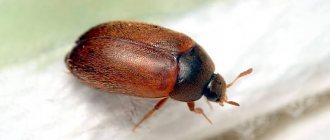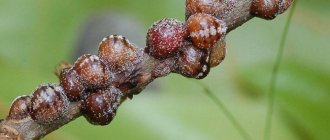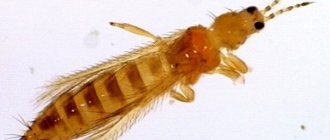Description, photo of the parasite and the affected plant
The pest feeds on plant sap. The scale insect is covered with a kind of shield, so it cannot be destroyed simply with a chemical. In the photo you can see what scale insects look like on orchids.
The scale insect sticks to the orchid leaf and drinks juice from it.
Females and males are covered with a shield that protects them from harmful influences. At the same time, males are quite mobile, and females are attached to one place and give birth to children. At one time, a female can produce 3 thousand larvae , which remain mobile for a short period of time.
Definition: what kind of parasite is this?
The scale insect (family Diaspididae) and the false scale insect (family Coccidae) are representatives of the order of homoptera insects of the suborder Coccidae. Insects feed on the sap of plants (household, garden and forest) from:
- leaves;
- shoots;
- fruits;
- branches;
- trunks.
Depending on the species, the body can be rounded or elongated. Color varies from light to dark brown. Sometimes there is a purple tint. The body of the scale insect is covered with a waxy shell, which is protection for the future generation.
False scale insects are distinguished by the fact that they do not have a shell, and the larvae and eggs are protected by the dying skin of the female. The size of the scale insects of adult insects does not exceed 5 mm, and the size of the false scale insects does not exceed 7 mm.
Insect larvae are called strays. When they hatch from eggs, they spread throughout the plant. Juveniles are oval-shaped, light yellow in color and very mobile. They have eyes, three pairs of legs and antennae.
Stragglers attach to leaves and stems. The limbs gradually die off.
Insects are covered with a dense wax shell. The color of the shell varies from white to brown. The larvae molt twice and develop into adult females and males. Males become mobile. They grow legs and wings, but their mouthparts are atrophied. After fertilization they die. Depending on the species, females lay eggs under the shield or give birth to larvae (up to 1000 pieces). Then they die.
Types of scale insects
differs from the false scale insect :
- Scale insects have a convex shell;
- False scale insects have a flat shell.
There are different types of scale insects that are found on orchids:
- Californian;
- Brown;
- Oleander;
- Palm;
- Cactus.
You can add scale insects to your home collection by purchasing a new plant that is already infected and has larvae on it.
IMPORTANT! Any new plant must be quarantined, where it will stand separately from other plants for 2 weeks.
This time is necessary to ensure the health of the plant.
Preventive actions
Often, infection with scale insects occurs through new specimens that were purchased at flower shops. For this reason, before purchasing a plant, it is necessary to inspect it carefully. And if warts, bulges, dark spots or sticky honeydew are found on the flower, it is better to discard it.
However, even if no signs of the presence of scale insects have been identified, you should not immediately place the new plant on a shelf with other flowers. He needs to be quarantined for a couple of weeks. This time will be quite enough for parasites, if any, to manifest themselves.
And remember that the main enemies of scale insects are good lighting and humidity. Create the proper conditions for your orchids, and they will immediately become unattractive to pests.
How to identify an infection?
Scale insects prefer the hard leaves of orchids, on which they are located on both sides. They do it like this:
- They stick to one place;
- Pierce the leaf;
- And they suck the juice.
Later, a small hole with a yellow border remains . And there are a lot of such bites. All this causes great harm to the orchid. Since the number of holes grows rapidly and soon the sheet:
- Turns yellow;
- Dries out;
- And it disappears.
If treatment is not started in time, the orchid's leaf may dry out.
In this case, the waste product of the scale insect is a sticky substance located on the leaf plate. It attracts sooty fungus, which further accelerates the death of the plant.
Signs that the plant is affected by scale insects:
- Small parasites attach to all parts of the plant and this is noticeable by the light brown growths;
- When pressed, they are easily removed;
- The leaves have a transparent sticky coating;
- Leaf plates become deformed, fade and turn yellow, starting from the edge of the leaf.
If a scale insect is detected, it is worth starting treatment as quickly as possible so that it does not affect the entire orchid bush.
Biological characteristics
The scale insect is a member of the hemiptera family of scale insects. The size is small - up to 5 mm. Females and males differ in appearance and life cycle:
| Floor | Peculiarities | Harm to the orchid |
| Female | Individuals go through three stages of development with their characteristic neoteny. They reach sexual maturity already in the larval phase, when the limbs and visual organs are not yet formed. The body is covered with protection consisting of one or two layers of larval skin and a waxy part formed by secretion - this makes it difficult to fight the pest. | They parasitize flowers, pierce the epidermis with a sharp trunk and feed on plant sap. During life, honeydew is released - a sweet liquid that attracts ants to the orchid. The appearance of insects is accompanied by the rapid development of sooty fungus. |
| Male | Formed in 5 larval stages. At the initial stage, he does not differ in appearance from the female. Adults have wings. Unlike females, who lead a sedentary lifestyle, males are significantly active and move quickly. | By themselves, they do not cause harm, since they do not have reduced oral organs. But their main purpose is to fertilize dangerous females. Life expectancy is no longer than a day. |
Control measures
How to get rid of a pest? The first immediate step when a scale insect is detected is to separate the infected specimen into a quarantine zone.
This is necessary so that the males do not run over to neighboring flowers. Especially if the flowers are very dense.
During the entire treatment, the flower is in the quarantine zone and even 2 weeks later remains in it. This is necessary in order to be completely sure that the pest is no longer on the flower.
Way to get rid of scale insects:
- It is necessary to mechanically remove all visible shields, since the chemical will not get under them during processing;
- Wash all leaves and flower stalks with soapy water, getting rid of sticky residue;
- Only after this do they begin to process the plant.
If the infestation is small, then you can try to get rid of the insect using traditional methods , but with a large infestation they do not produce results.
Folk remedies
How to fight scale insects with folk remedies? Since this is not a new pest and people have been fighting it for a long time, there are certain folk remedies to get rid of it.
Garlic juice
To do this, cut off the tip of a clove of garlic and, using the protruding juice, treat the places on the leaf blades where the pest was noticed.
A folk remedy for fighting scale insects is rubbing the orchid leaves with garlic juice.
But if the damage occupies a large area, then the garlic is grated on a fine grater or crushed using another method, the main thing is that it releases juice and turns into pulp. After which this paste is spread on the affected leaf.
Olive oil
To do this, make a composition by mixing 2 tbsp. spoons of oil with a liter of water. The orchid is treated with this infusion with an interval of 7 days.
Soap and alcohol
To do this you need to mix :
- Liter of water;
- And 10 ml. alcohol;
- Adding 15 grams there. liquid soap or dishwashing detergent.
Mix everything thoroughly and wash the plant where the scale insect was noticed.
Biological agents
Fitoverm - fights scale insects quite well. It is used in cases where, for various reasons, it is impossible to carry out chemical treatment, and traditional methods do not help to completely get rid of it. This drug is of biological origin and is not dangerous for humans and their animals.
To make a solution of the drug, 2 ml. diluted in 200 gr. water and spray the affected plant . This drug can be used to treat other plants in the house to prevent the disease. You also need to wipe the place where the affected flower stood.
To completely remove scale insects, treatment is carried out three times after 7 days.
Fitoverm.
Promanal is considered non-toxic and is used at home not only against various types of scale insects, but also helps get rid of ticks and scale insects. It affects egg laying and the larvae die without hatching. When treating an orchid, it must be thoroughly sprayed so that the solution drips from the leaves. In this case, the substrate must also be treated, since it may contain eggs and larvae.
Promanal is a remedy that helps plants fight pests.
Avertin is a broad-spectrum drug designed to remove pests. It affects the nervous system of the pest, causing its paralysis. Processing is carried out according to the instructions indicated on the packaging.
Nemabakt - the weapon of this biological product is a nematode, which penetrates the scale insect larva and eats it. The drug is absolutely harmless to beneficial insects, people and pets. The nematode continues to fight the pest for quite a long time, and the latter has no chance of surviving against it.
Biological drug Nemabact.
Insecticides
If the orchid is completely affected by this harmful insect, then it is worth using chemicals that can save the plant. When working with such drugs, you must be careful and if they come into contact with the mucous membrane or skin of a person, you must rinse everything well under running water.
Permethrin
The drug is quite effective and one treatment is enough to remove the parasite.
Permethrin helps the orchid fight pests well.
Penetrates the scale insect through the skin.
Aktellik and Aktara
These drugs are treated three times with an interval of 5-6 days. It is very toxic and must be processed outside . Penetrates insects through the oral cavity.
Phosfamide and Methylmercaptophos
The drugs enter the insects through the sap of the plant, which becomes poisonous .
Whatever drug is chosen, it is diluted and used according to the instructions given on the package. Experienced flower growers believe that sometimes chemical treatment cannot be avoided when a large area in the greenhouse is infected or the flower itself is severely damaged by pests.
IMPORTANT! There is no need to increase the dosage or frequency of treatments - this can lead to the death of the plant.
Treatment: how to get rid of scale insects
It is very difficult to fight scale insects. But this does not mean at all that you cannot rid your flowers of unwanted tenants. First of all you need to:
- Isolate the infected plant.
- Take care to increase the humidity near the diseased flower. To do this, he needs to create a mini-greenhouse. This can be a glass jar or a plastic bag. The structure should be ventilated every day for at least half an hour.
- Check other plants for infection. Even if nothing is noticeable yet, this does not mean at all that scale insects from the diseased plant have not moved onto them. In addition, scale insects usually hide, so you need to check the axils of the lower leaves, pseudobulb involucres and other similar hiding places. If this is not done, in just a few weeks the pests will be able to build up a large population.
- Rinse the diseased plant with warm water. This will help wash away the young larvae and honeydew.
- You should not use growth regulators and stimulants, as well as fertilizers containing nitrogen, at this time, as this will only worsen the situation.
- Make sure there are no ants in the house, which is usually possible in the summer. These insects can spread pests to other plants, so if at least one individual is noticed in the house, action must be taken immediately.
Tip #2. Some of the males and larvae can be caught using sticky yellow plates, which are used to catch flies. The plates need to be changed every day.
Application of growth stimulants and nitrogen fertilizers
When getting rid of pests, you should not use :
- Various fertilizers;
- Growth stimulants.
At the time of illness, the orchid will not grow new leaves and it will not accept the stimulant. Therefore, an excess of nitrogen fertilizing will lead to softness of the leaf plates and the possibility of their rotting. All the flower needs is a poison that will rid it of the pest.
Species that parasitize orchids
Scale insects affect many orchids, but more often than others they settle on plants with hard elastic leaves: paphiopedilums, dendrobiums, stangopeas, cymbidiums, cattleyas, phalaenopsis, bletillas, pleion.
The most famous types of scale insects seen on orchids are:
Palm tree (Diaspis boisduvalii) is a whitish-yellow or light brown insect. The female's body is short-oval, the scutellum is round. The protective shell of the male is long. More often it settles on palm trees, especially young fan palms, and banana plants, but if an orchid is nearby, it also moves to its foliage.
Palm (Diaspis boisduvalii)
Orchid (Pseudoparlatoria parlatorio >
Orchid (Pseudoparlatoria parlatorioides)
Bromeliad (Diaspis bromeliae) – yellowish-cream color, small, only up to 2.5 mm long. The body is pear-shaped and appears translucent. The scutellum is rounded, in the male it is long. Harmful to palm trees, orchids and bromeliads.
Bromeliad (Diaspis bromeliae)
Orchid comma (Lep >
Orchid comma (Lepidosaphes machili)
Oleander (Asp >
Oleander (Aspidiotus nerii)
The soft scale insect (Coccus hesperidum) is a viviparous insect that can give birth to up to 1 thousand young individuals. The scutellum is flat, elliptical, yellow-brown in color, with a distinct vein in the middle. The insect's body is asymmetrical and broadly elliptical. Settles on leaf blades on the lower and upper sides, on stems and tuberidia.
Soft scale insect (Coccus hesperidum)
Hemispherical false shield (Saissetia coffeae) - named for the shape of a flat-convex shield, reaching a length of 4 mm, smooth and dark brown to blackish in color. After the eggs mature, the female dies, the shell rises, and the larvae crawl at a very fast pace along the leaf or stem.
Hemispherical false scale (Saissetia coffeae)
Symptoms of the presence and habitat of scale insects on an orchid
The newly acquired orchid should be carefully examined, especially the axils of the leaves, the bases of the flowering stems, look behind the pseudobulb scales and on the underside of the leaf blades - these are the places where pests that have not yet settled en masse on the flower hide.
A sticky substance covered with a grayish coating is a sure sign of the presence of scale insects on the plant, and you need to look closely; sometimes it can be very difficult to detect brownish bulges.
The appearance of small yellow spots on leaves that are losing turgor is also often associated with the activity of the pest. Usually the yellowness gradually increases, the leaf dies and falls off. Sucking juices from flowering stems leads to the fall of unopened buds, and sometimes to inhibition or stop of their development.
A plant affected by scale insects weakens, the color and shape of the flowers change, the leaves wither, turn yellow and dry out. Only timely measures taken to destroy the pest help save the orchid.











